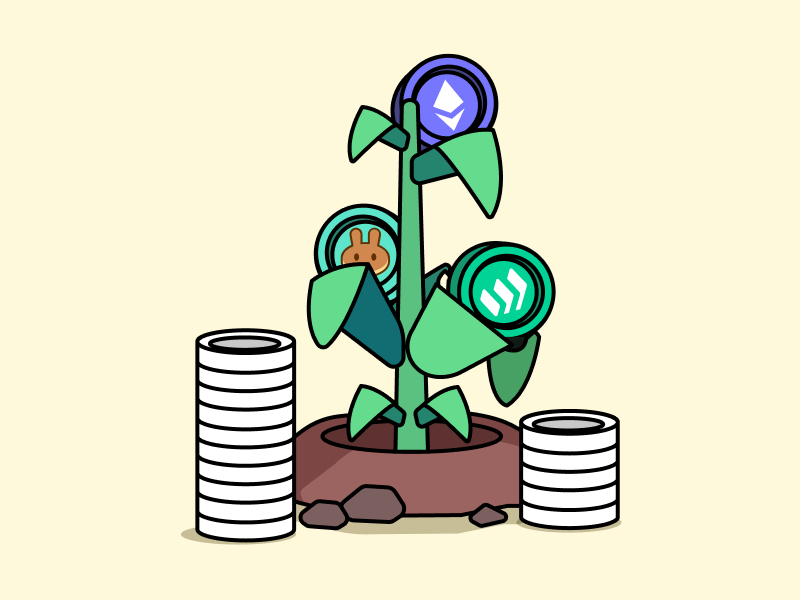
Yield farming is a practice in decentralized finance (DeFi) where cryptocurrency holders can maximize their returns by utilizing various DeFi protocols. It emerged from the Ethereum blockchain and has changed how investors interact with DeFi products. Yield farming enables investors not just to hold cryptocurrencies but also to participate in liquidity provision and governance.
Yield Farming and DeFi go hand in hand, as the concept of liquidity pools and automated market makers (AMMs) represents a shift from traditional financial systems to a more decentralized and user-centric economic model. Although Yield Farming was initially a niche practice, it quickly gained the attention of the broader crypto community.
This article dives deeper into the significance of Yield Farming and how it fits into the DeFi ecosystem.
Before getting into the article, here are a couple of key concepts that will help navigate the main fundamentals around Yield Farming:
- Liquidity pools are pools of tokens locked in a smart contract. They facilitate trading by providing liquidity, and liquidity providers earn fees from the trades.
- LP Tokens: When users deposit assets into a liquidity pool, they receive LP tokens representing their pool share. These tokens can sometimes be used for additional yield-generating activities.
- Annual Percentage Yield (APY): This is the rate of return earned on an investment over a year. In Yield Farming, APY can vary significantly based on the underlying protocol and market conditions.
- Compounding Returns: Yield Farming strategies often involve reinvesting the earned rewards to compound returns, amplifying the growth of the initial investment over time.
- Impermanent Loss: Occurs when the price of tokens in a liquidity pool changes compared to when they were deposited, potentially leading to a loss compared to simply holding the tokens.
- Governance Tokens: Many DeFi protocols issue their tokens, which grant holders governance rights, such as voting on protocol upgrades or changes.
- Staking: Apart from liquidity pools, Yield Farming can involve staking tokens directly in a protocol to earn rewards, often in the form of additional tokens.
Image Source: Pintu Website
Technical Aspects of Yield Farming
Liquidity pools form the foundation of many DeFi protocols that involve Yield Farming. These pools are funds locked in a smart contract, which is used to facilitate decentralized trading, lending, and borrowing—users, known as liquidity providers (LPs), deposit pairs of tokens into these pools. In return, they receive some transaction fees or other rewards the protocol generates.
This mechanism is integral to decentralized exchange (DEX) platforms such as Uniswap or SushiSwap.
Examples of DeFi Protocols:
- Uniswap: A pioneer in decentralized exchanges, Uniswap uses an automated market maker (AMM) model. It allows users to trade tokens directly from liquidity pools.
- Compound is a leading DeFi lending platform on which users can lend or borrow cryptocurrencies and earn or pay interest dynamically based on supply and demand.
- Aave: Similar to Compound, Aave offers lending and borrowing services with unique features like flash loans and a more comprehensive range of supported assets.
Yield Farming and the DeFi Ecosystem
Yield Farming has been crucial in driving innovation and growth in the DeFi sector. By incentivizing liquidity provision, it has addressed one of the significant challenges in decentralized markets - the lack of liquidity. As a result, DeFi platforms have become more efficient and accessible to a broader audience.
The landscape of Yield Farming is constantly evolving, with new protocols and strategies emerging regularly. This reflects the innovative spirit of the crypto community but also adds layers of complexity and potential risk. Looking ahead, Yield Farming is likely to remain a vital component of the DeFi ecosystem, although it may transform response to regulatory developments, technological advancements, and shifts in market dynamics.
Yield Farming has broader implications beyond DeFi and influences the more comprehensive blockchain and cryptocurrency landscape. It has introduced a new token distribution model, governance, and community engagement. Additionally, it has raised important questions about sustainability, risk management, and the balance between decentralization and regulation.
Final remarks
Yield Farming represents a paradigm shift in the world of finance, embodying the principles of decentralization, transparency, and user empowerment central to the blockchain. As the DeFi sector matures, Yield Farming will likely evolve, adapting to new challenges and opportunities. It stands as a testament to the innovative potential of blockchain technology and its ability to reimagine traditional financial systems.




